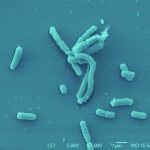Link to Pubmed [PMID] – 24292564
Link to DOI – 10.1007/s00125-013-3107-6
Diabetologia 2014 Feb; 57(2): 402-12
Skin lesions and ulcerations are severe complications of diabetes that often result in leg amputations. In this study we investigated the function of the cytoskeletal protein flightless I (FLII) in diabetic wound healing. We hypothesised that overexpression of FLII would have a negative effect on diabetic wound closure and modulation of this protein using specific FLII-neutralising antibodies (FnAb) would enhance cellular proliferation, migration and angiogenesis within the diabetic wound.Using a streptozotocin-induced model of diabetes we investigated the effect of altered FLII levels through Flii genetic knockdown, overexpression or treatment with FnAb on wound healing. Diabetic wounds were assessed using histology, immunohistochemistry and biochemical analysis. In vitro and in vivo assays of angiogenesis were used to assess the angiogenic response.FLII levels were elevated in the wounds of both diabetic mice and humans. Reduction in the level of FLII improved healing of murine diabetic wounds and promoted a robust pro-angiogenic response with significantly elevated von Willebrand factor (vWF) and vascular endothelial growth factor (VEGF)-positive endothelial cell infiltration. Diabetic mouse wounds treated intradermally with FnAb showed improved healing and a significantly increased rate of re-epithelialisation. FnAb improved the angiogenic response through enhanced formation of capillary tubes and functional neovasculature. Reducing the level of FLII led to increased numbers of mature blood vessels, increased recruitment of smooth muscle actin-α-positive cells and improved tight junction formation.Reducing the level of FLII in a wound may be a potential therapeutic approach for the treatment of diabetic foot ulcers.


